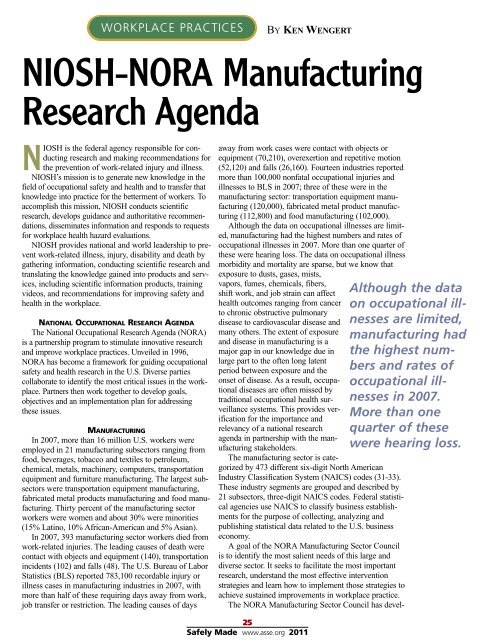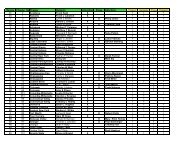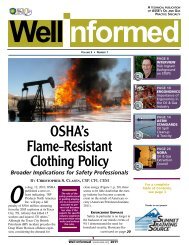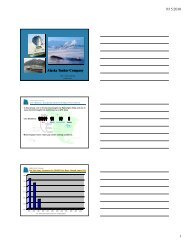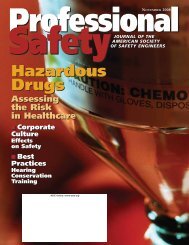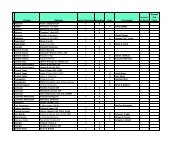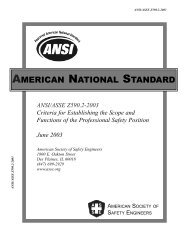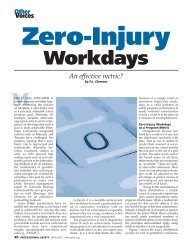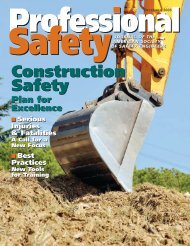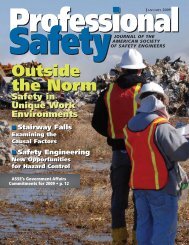Safety & Health Effects of Shift Work - ASSE Members
Safety & Health Effects of Shift Work - ASSE Members
Safety & Health Effects of Shift Work - ASSE Members
You also want an ePaper? Increase the reach of your titles
YUMPU automatically turns print PDFs into web optimized ePapers that Google loves.
WORKPLACE PRACTICES<br />
BY KEN WENGERT<br />
NIOSH-NORA Manufacturing<br />
Research Agenda<br />
NIOSH is the federal agency responsible for conducting<br />
research and making recommendations for<br />
the prevention <strong>of</strong> work-related injury and illness.<br />
NIOSH’s mission is to generate new knowledge in the<br />
field <strong>of</strong> occupational safety and health and to transfer that<br />
knowledge into practice for the betterment <strong>of</strong> workers. To<br />
accomplish this mission, NIOSH conducts scientific<br />
research, develops guidance and authoritative recommendations,<br />
disseminates information and responds to requests<br />
for workplace health hazard evaluations.<br />
NIOSH provides national and world leadership to prevent<br />
work-related illness, injury, disability and death by<br />
gathering information, conducting scientific research and<br />
translating the knowledge gained into products and services,<br />
including scientific information products, training<br />
videos, and recommendations for improving safety and<br />
health in the workplace.<br />
NATIONAL OCCUPATIONAL RESEARCH AGENDA<br />
The National Occupational Research Agenda (NORA)<br />
is a partnership program to stimulate innovative research<br />
and improve workplace practices. Unveiled in 1996,<br />
NORA has become a framework for guiding occupational<br />
safety and health research in the U.S. Diverse parties<br />
collaborate to identify the most critical issues in the workplace.<br />
Partners then work together to develop goals,<br />
objectives and an implementation plan for addressing<br />
these issues.<br />
MANUFACTURING<br />
In 2007, more than 16 million U.S. workers were<br />
employed in 21 manufacturing subsectors ranging from<br />
food, beverages, tobacco and textiles to petroleum,<br />
chemical, metals, machinery, computers, transportation<br />
equipment and furniture manufacturing. The largest subsectors<br />
were transportation equipment manufacturing,<br />
fabricated metal products manufacturing and food manufacturing.<br />
Thirty percent <strong>of</strong> the manufacturing sector<br />
workers were women and about 30% were minorities<br />
(15% Latino, 10% African-American and 5% Asian).<br />
In 2007, 393 manufacturing sector workers died from<br />
work-related injuries. The leading causes <strong>of</strong> death were<br />
contact with objects and equipment (140), transportation<br />
incidents (102) and falls (48). The U.S. Bureau <strong>of</strong> Labor<br />
Statistics (BLS) reported 783,100 recordable injury or<br />
illness cases in manufacturing industries in 2007, with<br />
more than half <strong>of</strong> these requiring days away from work,<br />
job transfer or restriction. The leading causes <strong>of</strong> days<br />
away from work cases were contact with objects or<br />
equipment (70,210), overexertion and repetitive motion<br />
(52,120) and falls (26,160). Fourteen industries reported<br />
more than 100,000 nonfatal occupational injuries and<br />
illnesses to BLS in 2007; three <strong>of</strong> these were in the<br />
manufacturing sector: transportation equipment manufacturing<br />
(120,000), fabricated metal product manufacturing<br />
(112,800) and food manufacturing (102,000).<br />
Although the data on occupational illnesses are limited,<br />
manufacturing had the highest numbers and rates <strong>of</strong><br />
occupational illnesses in 2007. More than one quarter <strong>of</strong><br />
these were hearing loss. The data on occupational illness<br />
morbidity and mortality are sparse, but we know that<br />
exposure to dusts, gases, mists,<br />
vapors, fumes, chemicals, fibers,<br />
shift work, and job strain can affect<br />
health outcomes ranging from cancer<br />
to chronic obstructive pulmonary<br />
disease to cardiovascular disease and<br />
many others. The extent <strong>of</strong> exposure<br />
and disease in manufacturing is a<br />
major gap in our knowledge due in<br />
large part to the <strong>of</strong>ten long latent<br />
period between exposure and the<br />
onset <strong>of</strong> disease. As a result, occupational<br />
diseases are <strong>of</strong>ten missed by<br />
traditional occupational health surveillance<br />
systems. This provides verification<br />
for the importance and<br />
relevancy <strong>of</strong> a national research<br />
agenda in partnership with the manufacturing<br />
stakeholders.<br />
The manufacturing sector is categorized<br />
by 473 different six-digit North American<br />
Industry Classification System (NAICS) codes (31-33).<br />
These industry segments are grouped and described by<br />
21 subsectors, three-digit NAICS codes. Federal statistical<br />
agencies use NAICS to classify business establishments<br />
for the purpose <strong>of</strong> collecting, analyzing and<br />
publishing statistical data related to the U.S. business<br />
economy.<br />
A goal <strong>of</strong> the NORA Manufacturing Sector Council<br />
is to identify the most salient needs <strong>of</strong> this large and<br />
diverse sector. It seeks to facilitate the most important<br />
research, understand the most effective intervention<br />
strategies and learn how to implement those strategies to<br />
achieve sustained improvements in workplace practice.<br />
The NORA Manufacturing Sector Council has devel-<br />
Although the data<br />
on occupational illnesses<br />
are limited,<br />
manufacturing had<br />
the highest numbers<br />
and rates <strong>of</strong><br />
occupational illnesses<br />
in 2007.<br />
More than one<br />
quarter <strong>of</strong> these<br />
were hearing loss.<br />
25<br />
Safely Made www.asse.org 2011


